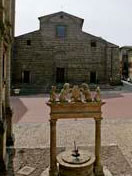- The name of Montepulciano derives from Latin Mons and Publicianus ("Mount of Publicianus").
Based on tradition, Montepulciano, has been founded by Porsenna, king of the Etruscans, although the oldest documents that testify to the existance of the city date from 714-715 A.D., when a "Politioum Castle" was cited in the documents regarding a dispute between the bishops of Siena and Arezzo for the possession of eighteen parishes.
The first core of inhabitation was developed at the top of the hill that today comprises the area between the Fortress and the St. Francis Church. The actual dimension it had reached at the end of the XIII Century but it was during the 1400's and 1500's that Montepulciano underwent an important transformation that lead to its enrichment with numerous Renaissance buildings.
Its highest splendor, as a matter of fact, began at the end of 1500, when it became an episcopate and part of the House the Medici, becoming one of the most privileged centers of the Grand Duchy of Tuscany.
Today it is possible to admire the rare beauty of the numerous palaces and religious works with which, between the XIV and the XV century, knowledgeable architects of those times (such as San Gallo the Elder, Michelozzo and Vignola) enriched the small town.
Among the architectural works of art, we cannot skip mentioning the old and fascinating cellars where the “vino Nobile di Montepulciano” ages; this was the first Italian wine to receive the D.O.C. denomination in 1966 and that nowadays is still one of the sources of production of the country.
The famous dithyramb Bacchus in Tuscany (1685), written by Francesco Redi, poet and physician, in which, ideally going with Bacchus and Arianna to evaluate all the best wines in Tuscany, comes up with the motto which makes all the Poliziani (inhabitants of Montepulciano) very proud: Montepulciano is the king of every wine!
|















